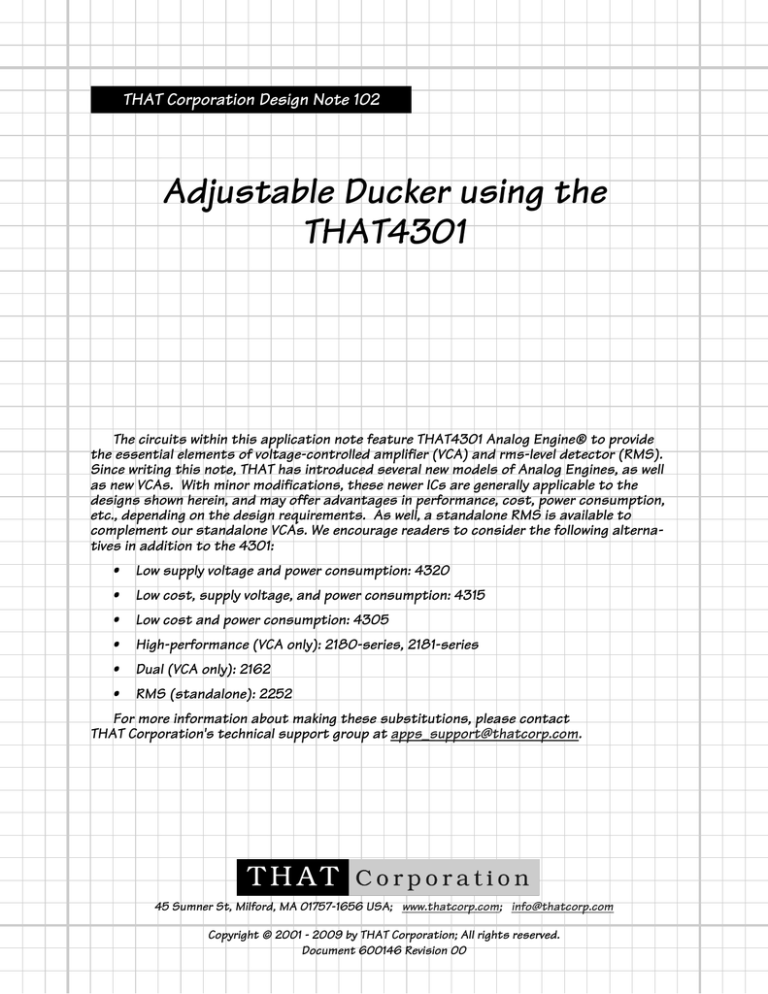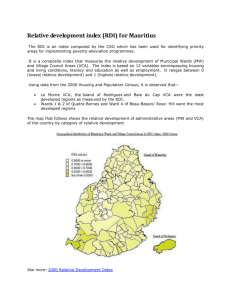
THAT Corporation Design Note 102
Adjustable Ducker using the
THAT4301
The circuits within this application note feature THAT4301 Analog Engine® to provide
the essential elements of voltage-controlled amplifier (VCA) and rms-level detector (RMS).
Since writing this note, THAT has introduced several new models of Analog Engines, as well
as new VCAs. With minor modifications, these newer ICs are generally applicable to the
designs shown herein, and may offer advantages in performance, cost, power consumption,
etc., depending on the design requirements. As well, a standalone RMS is available to
complement our standalone VCAs. We encourage readers to consider the following alternatives in addition to the 4301:
•
Low supply voltage and power consumption: 4320
•
Low cost, supply voltage, and power consumption: 4315
•
Low cost and power consumption: 4305
•
High-performance (VCA only): 2180-series, 2181-series
•
Dual (VCA only): 2162
•
RMS (standalone): 2252
For more information about making these substitutions, please contact
THAT Corporation's technical support group at apps_support@thatcorp.com.
45 Sumner St, Milford, MA 01757-1656 USA; www.thatcorp.com; info@thatcorp.com
Copyright © 2001 - 2009 by THAT Corporation; All rights reserved.
Document 600146 Revision 00
THAT Corporation Design Note 102
Adjustable Ducker using the THAT4301
Duckers are usually used to reduce the level of the main program material
during announcements. In this circuit, while the "voice over" signal is below
threshold, the main program passes through the VCA at a fixed gain, determined by the position of VR4.
The RMS detector, which senses the level of the "voice over" signal, is set for
a zero dB reference level of -10dBu. This level has been chosen arbitrarily, and
the circuit is configured for operation about -10dBu as follows:
V−
The timing current is determined by the equation: I t = R7
,
and the 0dB input reference current is related to It by the constant
9.6 % 10 −6 , as follows,
I in 0dB = 1.13 % I t
For a reference voltage of -10 dBu, the value of the RMS-Detector’s input
voltage-to-current resistor becomes
R1 =
V in 0dB
I in 0dB
=
0.245V
8.5A
l 28.8k
This setting will result in the RMS detector having zero volts out (and the
ducker having unity gain) when the "voice over" signal level is below -10 dBu. VR2
provides the means for user adjustment of this level.
The threshold amplifier's output, at the junction of D1, R2 and R6, is zero
volts when the "voice over" signal is below the threshold level, but decreases
rapidly once the gating signal exceeds threshold. In this design, a gain of 10 is
provided to aid in ducking the program material during announcements. Thus,
when the "voice over" signal is 3dB over threshold, the program material will be
suppressed by 30dB. The designer may wish to experiment with this gain level,
by varying R2, in order to get the right "feel" when ducking.
During ducking, the "voice over" signal is injected into the VCA's output
amplifier via R3. Note that there is an inversion for this signal that is not
present in the program material. This should be of little consequence for
announcements, though the designer may want to include an inverter in the
"voice over" signal path if using this circuit in other applications such as
"punching in" audio during recording, in order to maintain phase integrity.
In this design, we have chosen a relatively slow time constant, but this can
easily be altered by C4. See the THAT4301 datasheet for details.
Copyright © 2001-2009
by THAT Corporation
All rights reserved.
45 Sumner St, Milford, MA 01757 USA; www.thatcorp.com
Design Note 102
Page 2 of 3
Doc. 600146 Rev. 00
THAT Corporation Design Note 102
Voice Over
C7
Adjustable Ducker using the THAT4301
R3
20k0
47u
V+
V+
R9
VR1
50k
300k 5%
V-
51R 5%
Sym
Main Input
Comp.
Threshold
VR2
10k
cw
C1
47u
R4
R2
24k9
C8
+20 dBu
V-
D2
Threshold at -10dBu
R1
28k7
1
2
U1B
IN
RMS
IT
OUT
CT
4301P
R7
2M00
V-
R11
20k0
47u
383k
4
R13
5
4k99
20 OA1
18
4301P
C4
47u
V+=15V
V-=-15V
22u
R10
15
EC+ 14
SYM
11
V+
13
17
IN
OUT
VGND 10
EC- 9
16
V-
20k0
U1A
OA3
12
4301P
R12
100R
5%
Output
10n
1N4148
U1D
19
C3
47p NPO 5%
C2
V+
-40 dBu
C6
R8
cw
1N4148
D1
+20 dB
V+
C5
6k19
47n MY
R14
cw
R15
VR4
10k
-20 dB
R6
1M43
V-
6
12K4
U1C
8 OA2
age
t
l
o
v
l
contro
7
4301P
Gain
Figure 1: Adjustable ducker
Copyright © 2001-2009
by THAT Corporation
All rights reserved.
45 Sumner St, Milford, MA 01757 USA; www.thatcorp.com
Design Note 102
Page 3 of 3
Doc. 600146 Rev. 00


